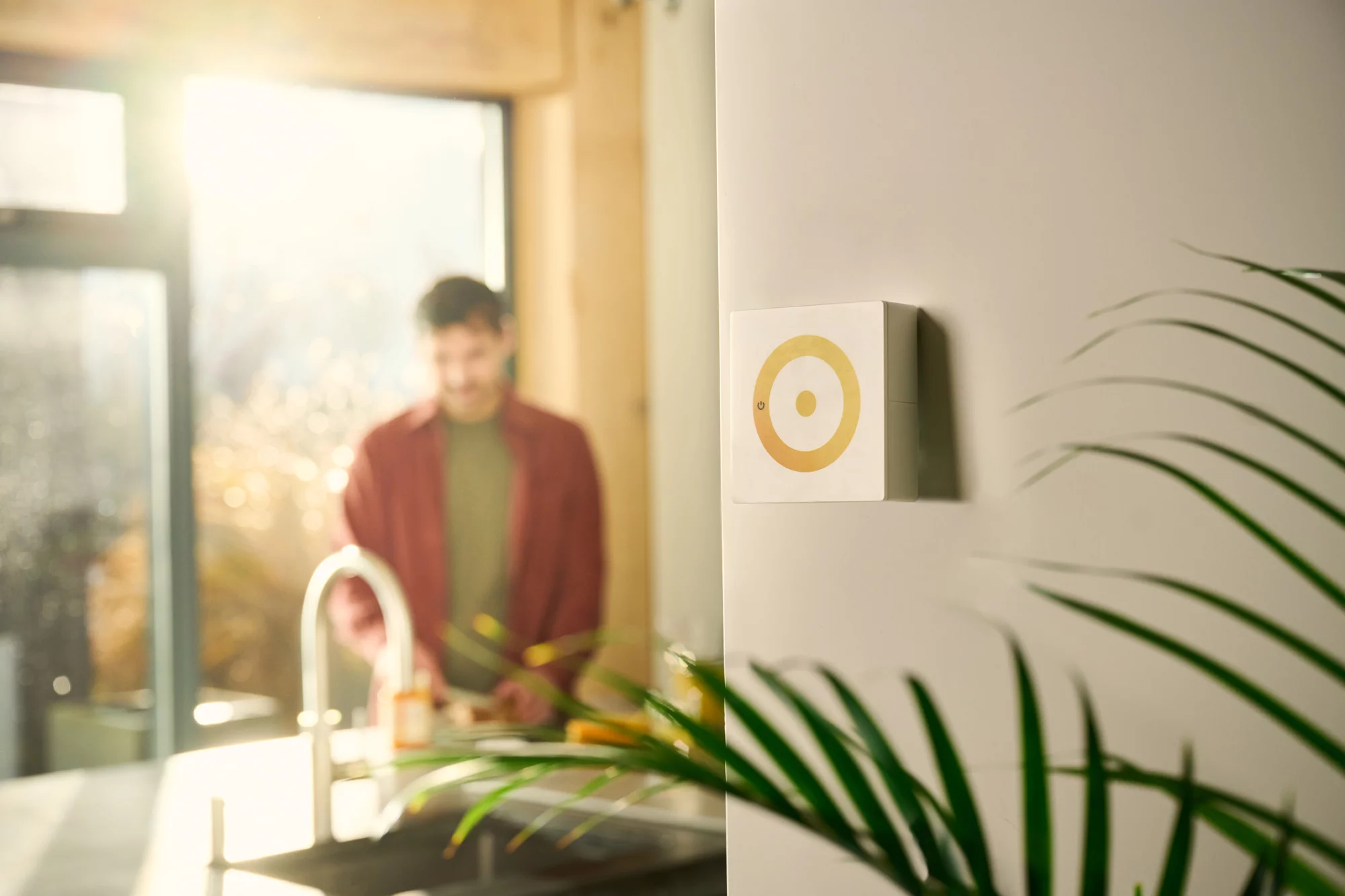From sunlight to power
How do solar panels work?
Everything you need to know about solar panels
Have solar panels piqued your interest? And would you like to know more about their operation and functionality? If so, please feel free to read on. On this page, we will provide you with as much general information about solar panels as possible – including the specifications, benefits, and features of a solar power system. Among other things, we discuss the sizes of a solar panel, Watt peak, kWh, the process of generating power, the service life of solar panels, and the payback period. You will thus be fully informed about solar panels.

This is how solar panels work
We are increasingly seeing solar panels on rooftops. But what exactly are solar panels? A solar panel is also known as a PV panel. The panels harness the inexhaustible energy of the sun. Every day, the sun rises and provides sunlight – even when it is cloudy. Solar panels convert the sun’s energy into electricity. The solar panels generate direct current, which is converted into alternating current by the inverter. We then use that alternating current in the kitchen, bathroom, or bedroom.
All about functionality
A solar panel is made up of dozens of solar cells – around 60 to 72 on average. These solar cells are essentially silicon wafers. A solar cell captures photons (i.e. tiny elementary particles of sunlight) and converts them into electrons. The incidence of sunlight creates a positive and negative voltage on either side of a solar panel, thereby generating an electric current. This process of generating energy from sunlight is referred to as the photovoltaic or photoelectric effect.
As the solar cells on a solar panel are sequentially arranged, the current will run to the inverter and be converted from direct current to functional alternating current at this point.
Developments in the energy market
The energy market has been evolving at lightning speed. As ever more people are switching to solar panels, solar boilers, and heat pumps, we need to match this speed. The demand for solar panels has been rising in the UK market. At a phenomenal rate. And that is probably because of rising energy prices. There is also a growing demand for home batteries; the alternative for when we will soon no longer be able to inject power into the grid.
No sun needed for solar power
Solar panels function using sunlight, right? Well, yes and no. A solar panel starts functioning only once the sun rises. So it does operate on the sun’s energy. Yet you don’t need sunshine to be able to generate solar energy. Even on cloudy days, you can still generate power with your solar panels. There is some diffused light on these cloudy days. The light reflected off the PV panel by clouds still releases energy. Fun fact: almost 60% of the energy generated from solar panels comes from diffused light.
We also know the module efficiency of a solar panel. This refers to how efficiently the panel converts sunlight into electricity. Across solar panels, module efficiency averages between 15% and 22%. At Soly, the module efficiency is as high as 20.5%. Excellent module efficiency.
Diffuse light solar panels
Diffuse light is sunlight on a cloudy day on which solar panels can still generate power. How does this differ from actual shadows falling on the solar panel. No power is generated in areas where shadow falls on the panel. When the PV panel is partly shaded, we structurally choose a parallel-connected solar panel system. This problem of shadows used to be resolved using bypass diodes, which simply skipped the shaded area. However, this had an impact on the overall yield of the system. So, this is why we use power optimisers. These small boxes are connected to each panel and create the right balance between voltage and current. This optimises the yield of the solar panels.
Solar panel specifications
Developments in the energy market have caused shifts in recent decades. Today, most solar panels are produced in China. China holds a technical lead in solar energy and currently has lower production costs than European and US competitors. One of the largest brands is Jinko Solar. This brand particularly stands out in terms of innovation, durability, and long-lasting quality. Although China’s reputation is not always strong, it does excel in solar energy.
Jinko Solar
At Soly UK, we’ve opted for solar panels from our partner Jinko Solar. We will always strive to provide a transparent comparison of the market. Unfortunately, we cannot compare all the different solar panels because of the complexity and size of the market. For solar panel specifications, we will restrict ourselves to the current solar panels offered by Soly UK: Jinko Solar 400-440 Wp solar panels.
Get to know our solar panels
Solar panel dimensions
The dimensions of a solar panel are given in length × width × depth, which may or may not be combined with the square metres (m2) for the area and weight of the system. The 400-420 Wp solar panels from Soly.be have dimensions of 1,722 × 1,134 × 30 mm. By the way: did you know
that the number of Watt peaks of a solar panel often also says something about its size? As the number of Watt peaks increases, so do the size, price, and yield of the solar panel.
The weight of solar panels
Have you ever held a solar panel? Chances are you were shocked by the weight. Solar panels are surprisingly heavy. The Jinko Tiger Neo N-Type Mono-Facial solar modules of 400–440 Wp weigh 22.0 kg. With the smallest system of six solar modules, you should therefore take into account a total load of about 132 kg for the construction. This excludes carriers, optimisers, and other materials used.
Watt peak and kWh of solar panels
What is the Watt peak and kWh of solar panels? Watt peak describes the peak power a solar panel can generate in electricity under the most favorable conditions. That means: south- facing, 35° inclination, the perfect temperature, and optimal solar irradiation. As you know, our solar panels currently have a peak output of 390 Wp. If you then wish to convert the number of Watt peaks to kWh (kilowatt hours), you take the average annual efficiency of a solar panel (i.e. 88%) as a starting point. As you can see, the average efficiency is not 100%. This is due to the varying slope angles and orientations of UK’s roofs combined with regular weather conditions in the United Kingdom. Then multiply the efficiency by the Watt peak in the following way (example Trina Vertex S Full Black): 0.88 × 390 = 343.2 kWh per year. Do you know your annual power consumption? You can then calculate exactly
how many solar panels you will need in order to offset your power consumption.
How is the Watt peak of solar panels determined?
There are dozens of manufacturers and hundreds of solar panel suppliers, and they all offer a different Watt peak. Why is that? The Watt peak of solar panels is accurately calculated in the laboratory. Here, the PV panels are tested under the most favourable conditions. Watt peak is calculated based on the module efficiency and dimensions of a solar panel. Module efficiency shows what percentage of sunlight can be converted into electricity whilst the dimensions allow for x number of solar cells per panel. As you know: the more solar cells, the more energy can be generated. This explains the creation of the Watt peak.
The colour of solar panels
In the solar panel market, colour is also an important aspect. Both visually and qualitatively. Why is that? Because there is a relationship between the colour and efficiency of solar panels. In fact, there are two fixed colours for solar panels: (dark) blue and black. There is still a colour palette within this. However, this does not affect the group itself. As a rule, black solar panels (Full Blacks) have a higher Watt peak, thus resulting in higher efficiency. The price for all-black solar panels will be slightly higher in reality. However, this is (more than) recouped in the form of higher returns over the years.
Lifespan of solar panels
What is the lifespan of solar panels? This is an important question because you would like to enjoy your rooftop system for as long as possible. The average lifespan of solar panels is between 30 and 40 years. However, this depends on the manufacturer and brand. Because the lifespan of a solar panel is so high, most manufacturers tend to issue a manufacturer’s warranty of 25 years or more. If your product becomes defective within this time frame, you can have it repaired or replaced under warranty depending on the situation.
Incidentally, over the service life of solar panels, there is a minute annual decrease in efficiency. We refer to this as the efficiency degradation of solar panels. After 30 to 40 years, the efficiency of the solar panels will have declined to such an extent that you will be advised to install a new system. Of course, you are free to replace the solar panels at an earlier stage, for example, because the potential efficiency of a new system is substantially higher than the initial installation of the old solar panels.
How does the inverter of solar panels work?
Solar panels are completely dependent on an inverter and vice versa. Both systems are matched in terms of size/weight. A shielded and well-insulated cable runs from the solar panels to the inverter. The inverter will convert the direct current from the solar panels into alternating current, which is suitable for use in the home. Incidentally, it is important to install the inverter in a cool place with sufficient ventilation space as when the inverter is inactive, it must be able to dissipate its heat.
Inverter specifications
The inverter is roughly the size of two shoe boxes. Which inverter you need depends on whether you choose a serial- or parallel-connected system. It should also match the output of the solar panels. For example, for a serial-connected system, we at Soly.be use the GroWatt inverter; for a parallel-connected system, we use the SolarEdge inverter. Read more about our products.
Injecting power into the grid
On sunny days, when you consume little power, you may have some self-generated power left over. You can inject this back into the grid. Just as you effectively have to pay for using the grid, with the right energy contract, you will be reimbursed for the power you inject into the grid. This is power you don’t need. The options for injecting power into the grid will expire in a few years. You can also opt for a home battery or the combination of solar panels and home battery.
To opt for solar panels or not?
Sustainability is a hot topic these days. Many households want to become less dependent on – or even completely independent of – the energy grid. At a national level, agreements on reducing the use of fossil fuels are being made. The energy transition is thus in full swing. Thanks to various premiums on solar panels and home batteries, UK households are being encouraged to opt for solar energy. And the opportunities are there. At Soly UK, you can choose to purchase solar panels – or to rent them at an extra low solar panel price.
Alternatives – or additions – include insulating your home or replacing old, energy-guzzling household appliances. All aim to save energy – and therefore money.
Saving on energy
Would you like to start saving money immediately and use less energy in your home? Then you will undoubtedly enjoy the efficiency of rooftop solar panels. Depending on your annual power consumption and the number of solar panels chosen, this will instantly reduce your dependence on the energy grid. That means you will pay less for your energy consumption from the very first day. Within a few years, you will have recouped the investment in a system with solar panels. After this, you can enjoy all the benefits for at least another 20 years.
Do you also want to save on your gas consumption? Then insulation is the best option. Insulation makes it easier to retain heat in your home and prevent cold outside air from entering. This reduces the need to turn on the heating and drastically scales down your gas consumption.
Solar panels or not? Purchase or rent? It depends on your actual situation.
Soly Blog


